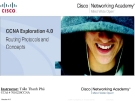
Route wan
-
Describe the basic purpose of a router – Computers that specialize in sending packets over the data network – They are responsible for interconnecting networks by selecting the best path for a packet to travel and forwarding packets to their destination Routers are the network center – Routers generally have 2 connections: • WAN connection (Connection to ISP) • LAN connection
 408p
408p  phutran76
phutran76
 03-05-2012
03-05-2012
 147
147
 44
44
 Download
Download
-
Không thể route giữa các mạng WAN thông qua chuyển mạch gói (switched circuits) hoặc đường điện thoại (dialup lines). Khả năng route này chỉ thực hiện được khi có WAN card (ví dụ T1 hay FrameRelay
 3p
3p  phanvanhuong12
phanvanhuong12
 11-04-2011
11-04-2011
 230
230
 81
81
 Download
Download
CHỦ ĐỀ BẠN MUỐN TÌM














